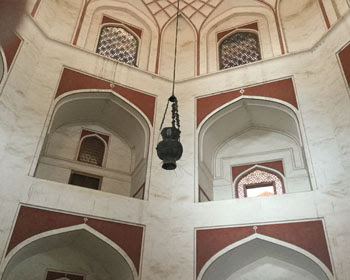Humayun's Tomb | Architecture | History | Entry Fees - My Eyes Of India
Humayun's tomb Delhi
Humayun's tomb is located in Delhi, India. It is situated at Nizamuddin East area of Delhi, it is the first garden-tomb in the Indian subcontinent. Humayun's tomb is the resting place of the Mughal Emperor Humayun, the name itself tells it. It is a typical Mughal architecture and it is made of red sandstones. It is one of the major attractions in Delhi. Humayun's tomb attracts many tourist peoples throughout the year. In this blog, we are going to see about Hamayun's tomb - history, architecture, entry fees, timings, and transportation.
History of Humayun's tomb
Humayun died in the year 1556 AD because he had a fall from stairs. Humayun was laid to rest at his palace at Purana Quilla in Delhi. After his death, Delhi was attacked by Hemu, the Hindu general and Chief Minister of Adil Shah Suri of Suri Dynasty. To preserve the sanctity of their Emperor’s remains, the retreating Mughal army exhumed Humayun’s remains and took them to be reburied at Kalanaur in Punjab. Following her husband’s death, the grieving queen Bega Begum began for Mecca to undertake the Hajj pilgrimage and vowed to create a powerful mausoleum in his memory.
The Bega Begum employed the services of a Persian architect, Mirak Mirza Ghiyas, hailing from the Herat region of Afghanistan and having a powerful repertoire. She not only commissioned and purchased the development of the tomb but supervised its construction also. The grandeur of this spectacular edifice gradually diminished thanks to a lack of maintenance as funds dwindled within the royal treasury of the declining Mughal Empire.
In 1880, after the establishment of British rule out Delhi, the encompassing garden was redesigned to accommodate an English style garden. However, it had been restored to the first style during a major restoration project between 1903 and 1909. The complex and its structures were heavily defiled when it had been wont to house the refugees during the 1947 Partition of India. The foremost recent phase of restoration started in 1993 after Humayun’s tomb was named as a UNESCO World Heritage Site, by the Archaeological Survey of India (ASI) – Aga Khan Trust for Culture (AKTC).
History Source: Cultural India
The architecture of Humayun's tomb
The structure of Humayun's tomb may be a mixture of Islamic and Persian architecture with smatterings of Indian elegance too. Six-sided stars that embellish the most opening on the west, also are seen on the most tomb structure, though it's been used as a patterned galactic symbol.
The tomb built of the debris of granite and red sandstone uses white marble as a building material. it's main features of Indian - Islamic architecture like jaalis, door frames, and Chhajja. It stands on a leaped terrace eight-meter high and covers 12,000-meter square. This tomb houses over 100 gravestones and therefore the entire base structure is elevated on a stage, a couple of steps high.

Entry Fees
- Rs. 10 per head for citizens of India. Rs. 250 per head for foreign nationals.
- No entry fees for Children up to 15 years.
Timings
Transportation
- By rail
Nizammudin is the nearest railway station and Jorbagh and Race Course stations are the nearest metro stations.
- By bus
To reach Humayun’s Tomb Complex, many AC/non AC buses can be taken from Rajiv Chowk/ISBT/Nizamuddin.
- By road
Autos and cabs are available there.









Comments
Post a Comment